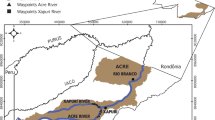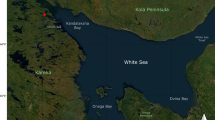Abstract
Purpose
The Antarctic dragonfish, Parachaenichthys charcoti is a notothenioid teleost fish endemic to the Southern Ocean surrounding Antarctica. It is a relatively rare fish species; therefore, published data on the parasite communities of P. charcoti are limited. The present study was performed on the Ukrainian Antarctic Station "Akademik Vernadsky", Argentine Islands, West Antarctica and the purpose was to examine the species diversity of the parasites of P. charcoti and to identify the parameters of helminth infection and helminth component community.
Methods
Fifteen specimens of P. charcoti were caught at a depth of 10–30 m and examined using standard parasitological techniques. All helminths (6251 specimens) were collected manually, fixed in 70% ethanol and identified based on their morphology.
Results
All examined specimens of P. charcoti were found to be infected with helminths; each fish harboured 10–20 helminth species (mean 13.2; median 13) and 237–804 helminth specimens (mean 417; median 401). Twenty-seven helminth species were found, including nine species of trematodes, 4 of cestodes, 4 of nematodes and 10 of acanthocephalans. P. charcoti is the definitive host for 11 out of 27 helminth species recorded. In the helminth component community, the diversity indices were 2.03 (Shannon's index) and 0.79 (Simpson's index); Pielou evenness index was 0.61, and Berger–Parker dominance index was 0.38.
Conclusions
Our results indicate a high species diversity and complex structure of the helminth community in Antarctic dragonfish P. charcoti in the Argentine Islands.

Similar content being viewed by others
References
Nybelin O (1951) Subantarctic and Antarctic Fishes. Scientific results of the ‘‘Brategg’’ expedition 1947–1948, vol 2. Publication Christensen Hvalfanstmuseum, p 1–32
Casaux RJ, Mazzotta AS, Barrera-Oro ER (1990) Seasonal aspects of the biology and diet of nearshore nototheniid fish at Potter Cove, South Shetland Islands. Antarctica Polar Biol 11(1):63–72. https://doi.org/10.1007/BF00236523
Casaux R, Barrera-Oro E, Baroni A, Ramon A (2003) Ecology of inshore notothenioid fish from the Danco Coast, Antarctic Peninsula. Polar Biol 26:157–165. https://doi.org/10.1007/s00300-002-0463-y
Manilo LG (2006) Ichthyofauna and morphobiological characteristics of mass fish species of coastal waters of Argentine Islands (Antarctica). Zbirnyk prats Zoologichnogo Muzeju 38:5–22 ([In Ukrainian])
Novillo M, Moreira E, Macchi G, Barrera-Oro E (2018) Reproductive biology in the Antarctic bathydraconid dragonfish Parachaenichthys charcoti. Polar Biol 41:2239–2248. https://doi.org/10.1007/s00300-018-2359-5
Veselskyy MV, Khoetskyy PB (2018) Ichthyofauna of the waters of the archipelago of the Argentine Islands (Ukrainian Antarctic expedition 2015–2016). Nauk Zap Ternop Nats Ped Un-ty. Ser Biol 1(72):36–43
Kompowski A, Rojas C (1994) On some biological characters of Parachaenichthys georgianus (Fischer, 1885) (Pisces, Notothenioidei, Bathydraconidae) from the shelf waters of South Georgia (Antarctica). Acta Ichthyol Piscat 24(2):61–75. https://doi.org/10.3750/AIP1994.24.2.08
Barrera-Oro E (2002) The role of fish in the Antarctic marine food web: differences between inshore and offshore waters in the southern Scotia Arc and west Antarctic Peninsula. Antarct Sci 14(4):293–309. https://doi.org/10.1017/S0954102002000111
Ahn DH, Shin SC, Kim BM, Kang S, Kim JH, Ahn I, Park J, Park H (2017) Draft genome of the Antarctic dragonfish, Parachaenichthys charcoti. Gigascience 6(8):1–6. https://doi.org/10.1093/gigascience/gix060
Daniels RA (1982) Feeding ecology of some fishes of the Antarctic Peninsula. Fish Bull US 80:575–588
Kompowski A (1992) Food and feeding behaviour of Parachaenichthys georgianus (Fischer, 1885) and Parachaenichthys charcoti (Vaillant, 1906) (Pisces, Bathydraconidae). Acta Ichthyol Piscat 22(1):15–29. https://doi.org/10.3750/AIP1992.22.1.02
Takahashi M, Iwami T (1997) The summer diet of demersal fish at the South Shetland Islands. Antarctic Sci 9:407–413. https://doi.org/10.1017/S0954102097000527
Reid K, Arnould JPY (1996) The diet of Antarctic fur seals Arctocephalus gazella during the breeding season at South Georgia. Polar Biol 16:105–114. https://doi.org/10.1007/BF02390431
Xavier JC, Trathan PN, Ceia FR, Tarling GA, Adlard S, Fox D et al (2017) Sexual and individual foraging segregation in Gentoo penguins Pygoscelis papua from the Southern Ocean during an abnormal winter. PLoS ONE 12(3):e0174850. https://doi.org/10.1371/journal.pone.0174850
Near TJ (2009) Notothenioid fishes (Notothenioidei). In: Hedges SB, Kumar S (eds) The time tree of life. Oxford University Press, pp 339–343
Szidat L, Graefe G (1967) Estudios sobre la fauna de parasitos de peces antarticos II-Los parasitos de Parachaenichthys charcoti. Servicio de Hidrografia Naval, Armada Argentina,República Argentina, Público H, 911, Buenos Aires, pp 1–27
Zdzitowiecki K (2001) Occurrence of endoparasitic worms in fish, Parachaenichthys charcoti (Bathydraconidae), off the South Shetland Islands (Antarctica). Acta Parasitol 46(1):18–23
Zdzitowiecki K (1983) Antarctic acanthocephalans of the genus Metacanthocephalus. Acta Parasitol Pol 28:417–437
Zdzitowiecki K (1986) Prevalence of acanthocephalans in fishes of South Shetland Islands (Antarctic) I. Juvenile Corynosoma spp. Acta Parasitol Pol 30:143–171
Zdzitowiecki K (1986) Prevalence of acanthocephalans in fishes of South Shetland Islands (Antarctic) III Metacanthocephalus johnstoni Zdzitowiecki, 1983, M. dalmori Zdzitowiecki, 1983 and notes on other species; general conclusions. Acta Parasitol Pol 31:125–141
Zdzitowiecki K (1988) Occurrence of digenetic trematodes in fishes off South Shetlands (Antarctic). Acta Parasitol Pol 33:155–167
Zdzitowiecki K (1990) Little known and new Antarctic digenean species of the genera Neolepidapedon and Lepidapedon (Lepocreadiidae). Acta Parasitol Pol 35:19–30
Zdzitowiecki K (1991) Occurrence of digeneans in open sea fishes off the South Shetland Islands and South Georgia, and the list of fish digeneans in the Antarctic. Pol Polar Res 12:55–72
Palm HW (1999) Ecology of Pseudoterranova decipiens (Krabbe, 1878) (Nematoda: Anisakidae) from Antarctic Waters. Parasitol Res 85:638–646. https://doi.org/10.1007/s004360050608
Rocka A (2006) Helminths of Antarctic fishes: Life cycle biology, specificity and geographical distribution. Acta Parasitol 51:26–35. https://doi.org/10.2478/s11686-006-0003-y
Faltýnková A, Georgieva S, Kostadinova A, Bray RA (2017) Biodiversity and Evolution of Digeneans of Fishes in the Southern Ocean. In: Klimpel S, Kuhn T, Mehlhorn H (eds) Biodiversity and evolution of parasitic life in the southern ocean. Parasitology Research Monographs, vol 9. Springer, Charm, pp 49–75. https://doi.org/10.1007/978-3-319-46343-8_5
Laskowski Z, Zdzitowiecki K (2017) Acanthocephalans in Sub-Antarctic and Antarctic. In: Klimpel S, Kuhn T, Mehlhorn H (eds) Biodiversity and evolution of parasitic life in the southern ocean. Parasitology Research Monographs, vol 9. Springer, Charm. https://doi.org/10.1007/978-3-319-46343-8_8
Wojciechowska A (1993) The tetraphyllidean and tetrabothriid cercoids from Antarctic bony fishes. I. Morphology. Identification with adult forms. Acta Parasitol 38:15–22
Rocka A (1999) Biometrical variability and occurrence of Ascarophis nototheniae (Nematoda, Cystidicolidae), a parasitic nematode of Antarctic and subantarctic fishes. Acta Parasitol 44:188–192
Palm HW, Klimpe S, Walter T (2007) Demersal fish parasite fauna around the South Shetland Islands; high species richness and low host specificity in deep Antarctic waters. Polar Biol 30:1513–1522. https://doi.org/10.1007/s00300-007-0312-0
Münster J, Kochmann J, Grigat J, Klimpel S, Kuhn T (2017) Parasite fauna of the Antarctic dragonfish Parachaenichthys charcoti (Perciformes: Bathydraconidae) and closely related Bathydraconidae from the Antarctic Peninsula. Southern Ocean. Parasit Vector 10:235. https://doi.org/10.1186/s13071-017-2176-7
Zdzitowiecki K, Laskowski Z (2004) Helminths of an Antarctic fish, Notothenia coriiceps, from the Vernadsky Station (Western Antarctica) in comparison with Admiralty Bay (South Shetland Islands). Helminthologia 41:201–207
Weber EP 3rd, Govett P (2009) Parasitology and necropsy of fish. Comp Contin Educ Vet 31(2):E12
Mozgovoy AA (1951) Ascaridata of animals and man, and the diseases caused by them. Osnovy nematodologii, vol 2. Izd-vo AN SSSR, Moskva, pp 1–616 (in Russian)
Zdzitowiecki K, Cielecka D (1997a) Digenea of fishes of the Weddell Sea. II. The genus Macvicaria (Opecoelidae). Acta Parasitol 42:77–83
Zdzitowiecki K, Cielecka D (1997) Digenea of fishes of the Weddell Sea. III. The Lepocreadiidae (genera Neolepidapedon and Lepidapedon), parasites of Notothenioidea. Acta Parasitol 42(2):84–91
Gibson DI, Jones A, Bray RA (2002) Keys to the Trematoda, vol 1. CABI & Natural History Museum, Wallingford, p 544
Jones A, Bray RA, Gibson DI (2005) Keys to the Trematoda, vol 2. CABI & Natural History Museum, Wallingford, p 768. https://doi.org/10.1079/9780851995878.0545
Zdzitowiecki K (1984) Some Antarctic acanthocephalans of the genus Corynosoma parasitizing Pinnipedia, with descriptions of three new species. Acta Parasitol Pol 29:359–377
Zdzitowiecki K (1984) Redescription of Corynosoma hamanni (Linstow, 1892) and description of C. pseudohamanni sp. n. (Acanthocephala) from the environs of the South Shetlands (Antarctic). Acta Parasitol Pol 29:379–393
Zdzitowiecki K (1987) Acanthocephalans of marine fishes in the regions of South Georgia and South Orkneys (Antarctic). Acta Parasitol Pol 31:211–217
Zdzitowiecki K (1996) Acanthocephala in fish in the Weddell Sea (Antarctica). Acta Parasitol 41:199–203
Bush AO, Lafferty KD, Lotz JM, Shostak AW (1997) Parasitology meets ecology on its own terms: Margolis et al. revisited. J Parasitol 83(4):575–583. https://doi.org/10.2307/3284227
Rósza L, Reiczigel J, Majoros G (2000) Quantifying parasites in samples of hosts. J Parasitol 86(2):228–232. https://doi.org/10.1645/0022-3395(2000)086[0228:QPISOH]2.0.CO;2
Clarke KR, Gorley RN (2006) PRIMER v6: User Manual/Tutorial (Plymouth Routines in Multivariate Ecological Research). PRIMER-E, Plymouth.
Amin OM (2013) Classification of the acanthocephala. Folia Parasitol 60(4):273–305. https://doi.org/10.14411/fp.2013.031
Kuzmina TA, Salganskij OO, Lisitsyna OI, Korol EM (2020) Helminths of Antarctic rockcod Notothenia coriiceps (Perciformes, Nototheniidae) from the Akademik Vernadsky Station area (Argentine Islands, West Antarctica): new data on the parasite community. Zoodiversity 54(2):99–110. https://doi.org/10.15407/zoo2020.02.099
Linse K, Griffiths HJ, Barnes DKA, Clarke A (2006) Biodiversity and biogeography of Antarctic and sub-Antarctic mollusca. Deep-Sea Res II:985–1008. https://doi.org/10.1016/j.dsr2.2006.05.003
Acknowledgements
The authors thank Prof. Terry R. Spraker from the Colorado State University for his valuable comments and corrections to the manuscript. This study was partially supported by the National Research Foundation of Ukraine (Project Number 2020.02/0074) and by the National Antarctic Scientific Center, Ministry of Education and Science of Ukraine (Project Number H/12-2020).
Author information
Authors and Affiliations
Corresponding author
Ethics declarations
Conflicts of interest/Competing interests
The authors declare that they have no conflict of interest.
Additional information
Publisher's Note
Springer Nature remains neutral with regard to jurisdictional claims in published maps and institutional affiliations.
Rights and permissions
About this article
Cite this article
Kuzmina, T.A., Salganskij, O.O., Dykyy, I.V. et al. Helminths of the Antarctic dragonfish, Parachaenichthys charcoti (Perciformes, Notothenioidei, Bathydraconidae) Studied near Galindez Island (Argentine Islands, West Antarctica). Acta Parasit. 66, 1424–1430 (2021). https://doi.org/10.1007/s11686-021-00417-0
Received:
Accepted:
Published:
Issue Date:
DOI: https://doi.org/10.1007/s11686-021-00417-0




